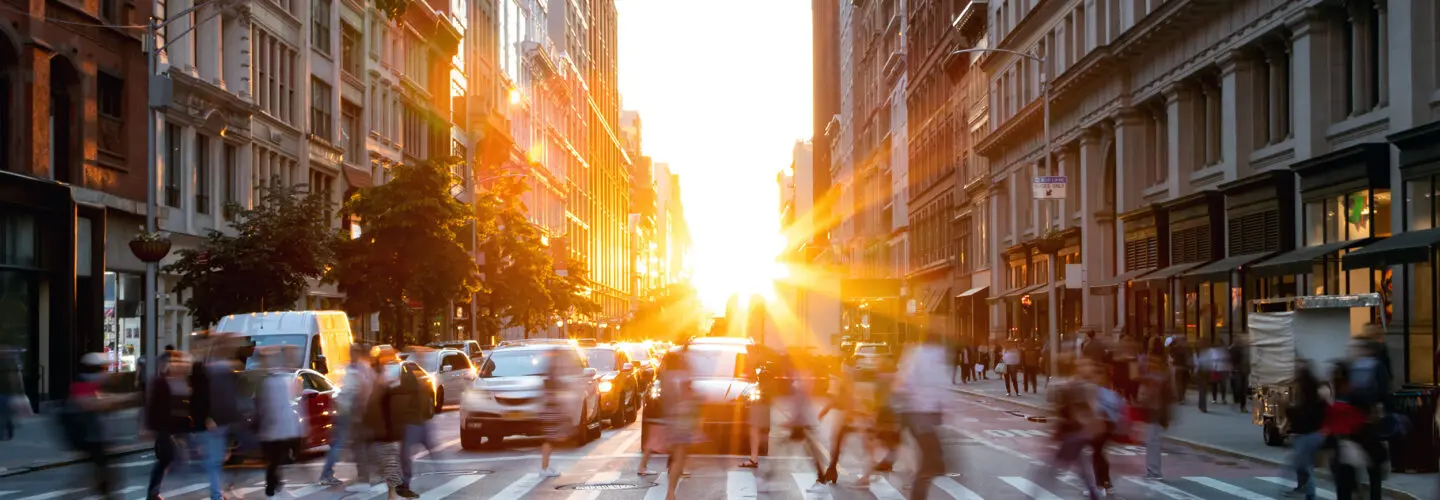Myth Busting: Congestion Pricing – Part II
Last July, Acadia Center published a myth busting blog tackling the controversial implementation of congestion pricing in New York City. Congestion is a policy designed to reduce traffic in the most congested areas of cities by charging vehicles a fee to enter designated areas. In New York, the plan imposed a charge on vehicles entering the highly congested lower part of Manhattan below 60th Street, aiming to cut down on traffic, improve air quality, and drive people toward the readily available public transit network, all while increasing funds for the Metropolitan Transportation Authority (MTA). Now that the policy has been in place for several months, it’s time to review just how effective it has been and what lessons can be learned.
So, has congestion pricing actually alleviated traffic congestion in NYC?
YES! The Congestion Pricing or Central Business District Tolling program, introduced on Jan 5, 2025, has led to noticeable and quantifiable reductions in traffic congestion within lower Manhattan.
Early numbers from the Metropolitan Transportation Authority (MTA) reported that since congestion pricing began in January 2025, traffic entering Manhattan’s Congestion Relief Zone has significantly declined. Compared to historical averages:

- January 2025 saw 8% fewer daily vehicle entries, totaling 1.27 million fewer vehicles for the month.
- February 2025 saw a 12% drop, or about 2.03 million fewer vehicles.
- March 2025 saw a 13% reduction, with 2.54 million fewer vehicles compared to baseline levels.
These sustained month-to-month reductions in traffic entering lower Manhattan suggest that congestion pricing effectively decreases traffic. Although some worried that congestion pricing would simply shift traffic to other boroughs, data shows that this hasn’t happened, there has been no noticeable increase in traffic in areas like the Bronx or Staten Island according to Streetsblog NYC.
Beyond the raw numbers, commuters and travel services have also reported improved travel speeds and increase public transit ridership. According to Better Cities, the MTA is averaging 448 thousand more public transit riders per day this year, that growth alone is nearly 50% larger than the total daily ridership of DC’s Metro, the second-busiest subway system in the U.S.
The biggest ridership growth has been in bus ridership. Since Bus speeds across the Hudson and east river entrances to Manhattan are faster, ridership has increased service has increased. According to Streetsblog NYC, buses have started to move so much faster in NYC that the MTA has had to modify the bus schedules to reflect earlier arrival times.
Since congestion pricing began in NYC, how much has it raised for the MTA?
On Feb 2025, the MTA released a statement on revenue from congestion pricing:
“Since the first-in-the-nation program began on Sunday, Jan. 5, through Friday, Jan. 31, tolls from the CRZ generated $48.66 million in revenue with a net $37.5 million putting the program on track to generate the $500 million that the MTA initially projected. The MTA will continue to report revenues from this program monthly.”
According to the MTA, revenue generated from the Congestion Relief Zone will fund some of the region’s most important transit capital projects, including:
- Accessibility improvements at over 20 stations
- Modern signal systems on segments of the A/C and B/D/F/M lines for over 1.5 million daily riders
- Hundreds of new electric buses
- Second Ave Subway Phase 2 extension to East Harlem
- Critical projects that keep our system in good working condition, such as structural repairs, power system improvements, and upgrades to bus depots.
Has there been any impact on crime rates on public transit? Has the increased use increased or decreased criminal activity in the city?
Despite the increase in subway ridership, crime on the NYC subway system has declined. According to recent NYPD data reported by AMNY, felony crimes on the subway dropped 15%, in the first quarter of 2025. There were 437 felonies recorded from January through March, compared to 515 during the same period in 2024. The data suggests that increased transit use has not led to more crime, in fact, more eyes on the street may coincide with a safer system overall. On top of that the funds from congestion pricing will likely be used to improve infrastructure and fare gates that will continue to increase safety in the system.
Will the new administration be able to force the end of congestion pricing?
The Trump administration has stated opposition to the Congestion Pricing Program in NYC, with the US transportation secretary, Sean Duffy, demanding its termination. However, the MTA has filed a lawsuit challenging the federal government’s decision. The latest reporting from ABC News mentions that “Hochul and MTA Chair and CEO Janno Lieber have said they will not turn off the tolls without a court order.”




















Follow us